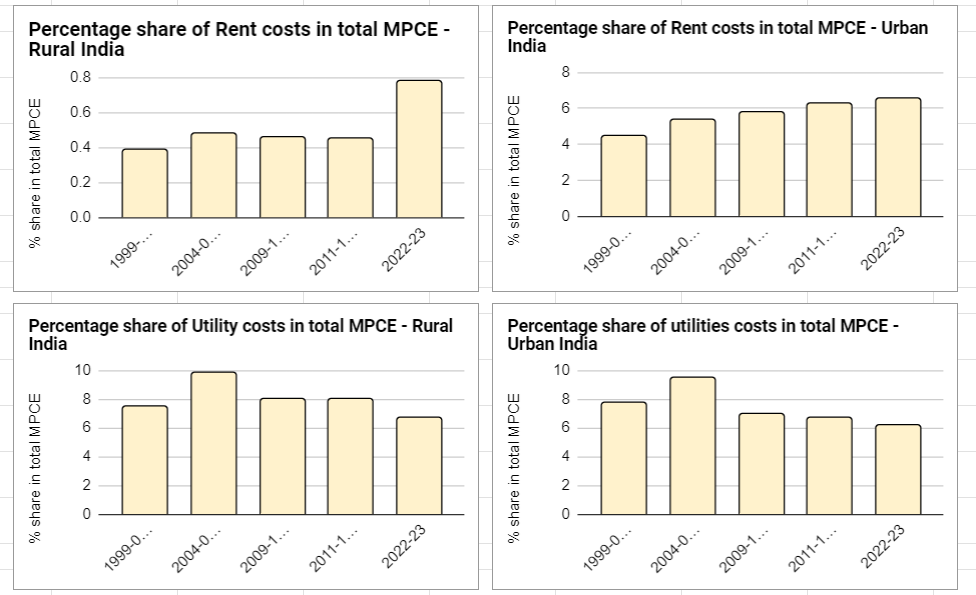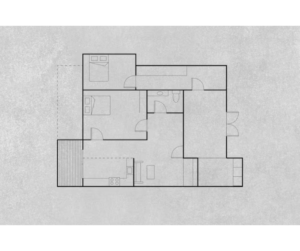The chasm between urban and rural India remains a persistent challenge. This disparity manifests in various aspects of life, including access to education, employment opportunities, infrastructure, and, crucially, household consumption patterns. Understanding the extent of Rural-Urban Inequality is essential for designing effective policies to bridge the gap and ensure equitable development.
This article delves into rural-urban Inequality inequalities in India through the lens of the latest Household Consumption Expenditure Survey (HCES) data released by the National Sample Survey Office (NSSO) in February 2024. The HCES provides valuable insights into consumption patterns across the country, offering a window into the economic realities of both urban and rural households.

Understanding rural-urban-inequality in India
Urban and rural India diverge significantly in their socio-economic characteristics. Urban areas tend to be more densely populated with higher median incomes and education levels. They also boast better access to essential services, markets, and employment opportunities.
In contrast, rural India is characterized by lower population density, lower median incomes, and higher poverty rates. Access to essential services and markets is often limited, impacting household consumption patterns. These factors contribute to a range of disparities between urban and rural populations.
Overview of HCES Data (2022-23)
The HCES, conducted by the NSSO, is a crucial data source on household consumption expenditure in India. The latest survey, covering the period from August 2022 to July 2023, provides insights into consumption patterns across different income groups, social categories, and geographical locations.
The HCES data is vital for policymakers, researchers, and development agencies as it allows for:
1. Analysis of trends in consumption: Tracking changes in expenditure patterns over time helps identify areas of progress and areas requiring policy intervention.
2. Assessment of living standards: The data provides a basis for understanding different population segments’ well-being and economic security.
3 .Evaluation of development programs: HCES data can be used to evaluate the effectiveness of government initiatives aimed at improving household consumption and reducing poverty.
The HCES is a comprehensive survey, collecting data on various aspects of household expenditure, including:
- Food and beverages
- Clothing and footwear
- Fuel and light
- Housing
- Education
- Healthcare
- Durable goods
- Transportation
- Other miscellaneous expenses
Here’s a detailed breakdown of key findings related to Housing:
Check our article on Affordable Housing at a Glance: Addressing the Homeless in India
Housing Expenditure:
The HCES data allows for an estimation of household expenditure on housing, encompassing rent, mortgage payments, repairs, and utilities. This data reveals a significant disparity between urban and rural areas. Urban households typically allocate a larger portion of their MPCE towards housing compared to rural households. This could be attributed to factors like:
Higher Rent Costs: Urban areas often experience higher rental costs due to limited land availability and greater demand for housing.
Formal Housing: Urban households are more likely to reside in formal housing structures with associated rental agreements or mortgage payments, leading to higher reported expenditure.
Utility Costs: Urban households tend to have greater access to amenities like electricity, running water, and sanitation, which can translate to higher utility costs reflected in housing expenditure.
| Absolute and percentage break-up of MPCE by item group in 2022-23: All-India | ||||
| MPCE (Rs.) | % share in total MPCE | |||
| Rural | Urban | Rural | Urban | |
| Rent | 30 | 423 | 0.78 | 6.56 |
| Utilities | 251 | 404 | 6.66 | 6.26 |
| Trend in percentage composition of MPCE since 1999-‘00: Rural India | |||||
| Item group | % share in total MPCE | ||||
| 1999-00 NSS (55th round) | 2004-05 NSS (61st round) | 2009-10 NSS (66th round) | 2011-12 NSS (68th round) | 2022-23 | |
| Rent | 0.39 | 0.48 | 0.46 | 0.45 | 0.78 |
| Utitlies | 7.52 | 9.81 | 8.03 | 7.98 | 6.66 |
| Trend in percentage composition of MPCE since 1999-‘00: Urban India | |||||
| Item group | % share in total MPCE | ||||
| 1999-00 NSS (55th round) | 2004-05 NSS (61st round) | 2009-10 NSS (66th round) | 2011-12 NSS (68th round) | 2022-23 | |
| Rent | 4.46 | 5.38 | 5.79 | 6.24 | 6.56 |
| Utitlies | 7.75 | 9.47 | 6.94 | 6.69 | 6.2 |

Rural Housing Characteristics:
While rural housing expenditure might appear lower, it’s crucial to consider the nature of rural dwellings. Rural households are more likely to:
Own Their Homes: A significant portion of rural households own their own homes, often passed down through generations. This ownership might not translate to direct expenditure in the HCES data.
Informal Housing Structures: Many rural dwellings might be constructed using locally sourced materials and traditional methods. These informal structures might not require significant monetary expenditure for maintenance or repairs.
Limited Amenities: Access to basic amenities like electricity, sanitation, and piped water might be limited in rural areas, leading to lower reported utility costs compared to urban areas.
Existing Policies and Strategies for Rural-Urban Inequality
Pradhan Mantri Awas Yojana (PMAY): This government initiative aims to provide affordable housing to all by 2022 (revised target). It offers subsidies for the construction and purchase of homes, particularly targeting rural and low-income urban households.
Learn more about PMAY Urban and Gramin – Affordable Housing In India
State-Specific Schemes: Several state governments have launched their own housing schemes, providing additional financial assistance and streamlining processes for acquiring affordable housing.
Focus on Rural Housing: Schemes like Pradhan Mantri Gramin Awas Yojana (PMAY-G) specifically target rural households, offering financial assistance for the construction of pucca (permanent) houses.
Challenges in Policy Implementation for Rural-Urban Inequality
Bureaucratic Hurdles: Complex application procedures and delays in approvals can hinder access to benefits under housing schemes.
Land Availability and Infrastructure: Limited land availability in urban areas and inadequate infrastructure in rural areas can present challenges for housing development.
Targeting and Beneficiary Identification: Ensuring schemes reach the most marginalized communities and genuine beneficiaries remains a challenge.
Future Perspectives :
Promoting Public-Private Partnerships (PPPs): Collaboration between government and private developers can leverage expertise and resources for large-scale affordable housing projects in both urban and rural areas.
Focus on Rental Housing: Encouraging and regulating rental housing markets can provide more flexible options for urban dwellers, particularly those struggling with mortgage payments.
Innovation in Construction Technologies: Adopting prefabrication techniques and promoting eco-friendly building materials can help accelerate housing construction while reducing costs.
Financial Inclusion for Rural Households: Expanding access to microfinance and other financial products can empower rural households to participate in formal housing markets.
Explore Homelessness: Solutions for Providing Housing
Utilizing HCES Data for Policy Improvement:
Identifying Regional Disparities: The HCES data, disaggregated by state, can help in identifying regions with the most prominent housing challenges, allowing for targeted policy interventions.
Understanding Socioeconomic Factors: Analyzing housing expenditure data alongside other HCES data points on income, social groups, and employment can provide a deeper understanding of how socioeconomic factors influence access to quality housing.
Monitoring Scheme Effectiveness: Utilizing HCES data can help track the progress of existing housing schemes and assess their effectiveness in bridging the urban rural housing divide.
Bridging the housing gap between urban and rural India requires a multifaceted approach. The HCES data serves as a valuable tool for understanding the nature and extent of this disparity. By analyzing spending patterns, quality of dwellings, and existing policies, stakeholders can develop more effective strategies to ensure access to safe, affordable, and quality housing for all, regardless of location. As India strives for inclusive development, addressing the housing challenge will be critical for improving the overall well-being of its citizens.
Refer these pages for more info on rural-urban-inequality
https://www.mospi.gov.in/sites/default/files/publication_reports/Factsheet_HCES_2022-23.pdf
https://www.policycircle.org/economy/hces-data-sparks-debate-poverty/






